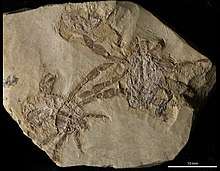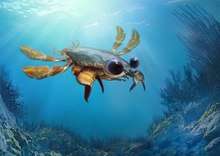Callichimaera
Callichimaera perplexa is a species of small crabs known from the Cretaceous of Colombia and the United States.[1] Because it possesses a strange combination of anatomical features, it is said to be the "platypus of crabs".[2] The presence of certain features in this species, such as its large claws and swimming limbs, confirm that those features were present in the crab lineage up to 95 million years ago.[3][4]
| Callichimaera | |
|---|---|
 | |
| Two fossil specimens of C. perplexa | |
| Scientific classification | |
| Kingdom: | Animalia |
| Phylum: | Arthropoda |
| Subphylum: | Crustacea |
| Class: | Malacostraca |
| Order: | Decapoda |
| Infraorder: | Brachyura |
| Section: | †Callichimaeroida |
| Superfamily: | †Callichimaeroidea |
| Family: | †Callichimaeridae |
| Genus: | †Callichimaera Luque et al., 2019 |
| Type species | |
| †Callichimaera perplexa Luque et al., 2019 | |
Etymology

The name Callichimaera perplexa translates to "perplexing beautiful crab".[2][5]
Description
Callichimaera possesses features that are commonly associated with the larval crab stage called the megalopa. This includes features like large compound eyes, a small fusiform body, and thin mouth parts.[1] However, the fossil crabs also show evidence of sexual maturity, suggesting they are adult forms.[1][6] This species likely evolved those larval features via a process called heterochrony.[1][7]
These crabs were small, with many that are nearly the size of a U.S. quarter.[1][5] The crabs range in size from a few millimeters up to two centimeters, also suggesting that both juveniles and adults are present.
Callichimaera does not have the typical crab-like shape, something that has occurred several times among crabs since the Cretaceous[1][8][9]
Because Callichimaera has large paddle-like legs, it was probably an active swimmer, opposed to predominantly living on the seafloor.[1]
Paleoecology
Callichimaera lived in a tropical environment.[1] Fossils are rarely preserved in tropical settings in comparison to other parts of the world, making this fossil an even more unusual discovery.
Callichimaera was discovered in deposits also containing comma shrimp and caridean shrimp.[10]
References
- Luque, J.; Feldmann, R. M.; Vernygora, O.; Schweitzer, C. E.; Cameron, C. B.; Kerr, K. A.; Vega, F. J.; Duque, A.; Strange, M.; Palmer, A. R.; Jaramillo, C. (24 April 2019). "Exceptional preservation of mid-Cretaceous marine arthropods and the evolution of novel forms via heterochrony". Science Advances. 5 (4): eaav3875. Bibcode:2019SciA....5.3875L. doi:10.1126/sciadv.aav3875. PMC 6482010. PMID 31032408.
- "Meet Callichimaera perplexa, the platypus of crabs". YaleNews. 24 April 2019. Retrieved 1 May 2019.
- "How did crabs evolve 'crabbiness'? It's complicated". Science & Innovation. 24 April 2019.
- "The funky-looking crab with eyes like mini-footballs". www.bbc.co.uk.
- "Newly discovered 'beautiful nightmare' crab had wrench-like claws and enormous, cartoonish eyes". Washington Post.
- "Enigmatic swimming crab fossil offers lessons on evolution's versatility".
- "Meet Callichimaera perplexa, Strangest Crab that Has Ever Lived | Paleontology | Sci-News.com". Sci News.
- "'Perplexing' New Crab Species Sheds Light on Crustacean Evolution". Discover. 29 April 2019.
- Wolfe, J.M.; Breinholt, J.W.; Crandall, K.A.; Lemmon, A.R.; Lemmon, E.M.; Timm, L.E.; Siddall, M.E.; Bracken-Grissom, H.D. (2019). "A phylogenomic framework, evolutionary timeline and genomic resources for comparative studies of decapod crustaceans". Proceedings of the Royal Society B. 286 (1901): 20190079. doi:10.1098/rspb.2019.0079. PMC 6501934. PMID 31014217.
- Luque, Javier; Gerken, Sarah (27 November 2019). "Exceptional preservation of comma shrimp from a mid-Cretaceous Lagerstätte of Colombia, and the origins of crown Cumacea". Proceedings of the Royal Society B: Biological Sciences. 286 (1916): 20191863. doi:10.1098/rspb.2019.1863. PMC 6939266. PMID 31771467.